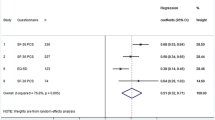Abstract
Purpose
The purpose of this study is to investigate whether inconsistently reported factors influence the health-related quality of life (HRQOL) outcome of partial meniscectomy.
Method
Short Form 36 (SF-36) data on 216 patients were retrospectively analysed for the influence of the factors age, gender and degree of cartilage degeneration. Mixed linear models were applied for univariate and multivariate analyses.
Results
All SF-36 scales, including the psychosocial scales, showed a significant improvement from pre- to post-operative (p < 0.001). The factor ‘degree of cartilage degeneration’ was found to significantly influence post-surgical improvement of the SF-36 ‘physical component summary’ score. Patients with mild cartilage degeneration benefited significantly more from surgery than did patients with advanced cartilage degeneration (p = 0.011). Older patients had significantly lower scores on each subscale, but showed no significant age–time interaction, that is, no association was seen between age and the degree of improvement. No effect was determined for the variable gender.
Conclusions
The findings of the current study can be interpreted to show that arthroscopic partial meniscectomy significantly improves HRQOL, even in mental or psychosocial dimensions of HRQOL. Not age but the degree of cartilage degeneration influences the HRQOL gain that can be expected. The factor gender has no effect on HRQOL. The findings of our study influence our daily routine, in that we take the degree of cartilage degeneration and not age as predictive value for the success to be anticipated from the procedure. Concerning the preoperative consenting, it is important to mention that advanced cartilage degeneration is a predictor of a less favourable outcome.
Level of evidence
IV.


Similar content being viewed by others
References
Bolano LE, Grana WA (1993) Isolated arthroscopic partial meniscectomy. Functional radiographic evaluation at five years. Am J Sports Med 21:432–437
Burks RT, Metcalf MH, Metcalf RW (1997) Fifteen-year follow-up of arthroscopic partial meniscectomy. Arthroscopy 13:673–679
Busija L, Osborne RH, Nilsdotter A, Buchbinder R, Roos EM (2008) Magnitude and meaningfulness of change in SF-36 scores in four types of orthopedic surgery. Health Qual Life Outcomes 6:55
Chatain F, Adeleine P, Chambat P, Neyret P (2003) A comparative study of medial versus lateral arthroscopic partial meniscectomy on stable knees: 10-year minimum follow-up. Arthroscopy 19:842–849
Desai VV, Ackroyd CE (2000) Resection of degenerate menisci—is it useful? Knee 7:179–182
Englund M, Lohmander LS (2004) Risk factors for symptomatic knee osteoarthritis fifteen to twenty-two years after meniscectomy. Arthr Rheum 50:2811–2819
Englund M, Paradowski PT, Lohmander LS (2004) Association of radiographic hand osteoarthritis with radiographic knee osteoarthritis after meniscectomy. Arthr Rheum 50:469–475
Englund M, Roos EM, Lohmander LS (2003) Impact of type of meniscal tear on radiographic and symptomatic knee osteoarthritis: a sixteen-year followup of meniscectomy with matched controls. Arthr Rheum 48:2178–2187
Englund M, Roos EM, Roos HP, Lohmander LS (2001) Patient-relevant outcomes fourteen years after meniscectomy: influence of type of meniscal tear and size of resection. Rheumatol (Oxf) 40:631–639
Ericsson YB, Ringsberg K, Dahlberg LE (2011) Self-efficacy, physical activity and health-related quality of life in middle-aged meniscectomy patients and controls. Scand J Med Sci Sports 21:e150–e158
Group TE (1990) EuroQol–a new facility for the measurement of health-related quality of life. Health Policy 16:199–208
Hede A, Larsen E, Sandberg H (1992) The long term outcome of open total and partial meniscectomy related to the quantity and site of the meniscus removed. Int Orthop 16:122–125
Hede A, Larsen E, Sandberg H (1992) Partial versus total meniscectomy. A prospective, randomised study with long-term follow-up. J Bone Joint Surg Br 74:118–121
Higuchi H, Kimura M, Shirakura K, Terauchi M, Takagishi K (2000) Factors affecting long-term results after arthroscopic partial meniscectomy. Clin Orthop Relat Res:161-168
ICRS cartilage injury evaluation pack. International Cartilage Repair Society. http://www.cartilage.org
Jorgensen U, Sonne-Holm S, Lauridsen F, Rosenklint A (1987) Long-term follow-up of meniscectomy in athletes. A prospective longitudinal study. J Bone Joint Surg Br 69:80–83
Maletius W, Messner K (1996) Chondral damage and age depress the long-term prognosis after partial meniscectomy. A 12 to 15-year follow-up study. Knee Surg Sports Traumatol Arthrosc 3:211–214
Maletius W, Messner K (1996) The effect of partial meniscectomy on the long-term prognosis of knees with localized, severe chondral damage. A twelve- to fifteen-year followup. Am J Sports Med 24:258–262
Matsusue Y, Thomson NL (1996) Arthroscopic partial medial meniscectomy in patients over 40 years old: a 5 to 11-year follow-up study. Arthroscopy 12:39–44
Morrissey MC, Milligan P, Goodwin PC (2006) Evaluating treatment effectiveness: benchmarks for rehabilitation after partial meniscectomy knee arthroscopy. Am J Phys Med Rehabil 85:490–501
Paradowski PT, Englund M, Lohmander LS, Roos EM (2005) The effect of patient characteristics on variability in pain and function over two years in early knee osteoarthritis. Health Qual Life Outcomes 3:59
Rockborn P, Gillquist J (1996) Long-term results after arthroscopic meniscectomy. The role of preexisting cartilage fibrillation in a 13 year follow-up of 60 patients. Int J Sports Med 17:608–613
Roos EM, Ostenberg A, Roos H, Ekdahl C, Lohmander LS (2001) Long-term outcome of meniscectomy: symptoms, function, and performance tests in patients with or without radiographic osteoarthritis compared to matched controls. Osteoarthritis Cartilage 9:316–324
Roos EM, Roos HP, Ryd L, Lohmander LS (2000) Substantial disability 3 months after arthroscopic partial meniscectomy: A prospective study of patient-relevant outcomes. Arthroscopy 16:619–626
Salata MJ, Gibbs AE, Sekiya JK (2010) A systematic review of clinical outcomes in patients undergoing meniscectomy. Am J Sports Med 38:1907–1916
Small NC, Sledge CB, Katz JN (1994) A conceptual framework for outcomes research in arthroscopic meniscectomy: results of a nominal group process. Arthroscopy 10:486–492
Ware JE Jr, Sherbourne CD (1992) The MOS 36-item short-form health survey (SF-36). I. Conceptual framework and item selection. Med Care 30:473–483
Author information
Authors and Affiliations
Corresponding author
Rights and permissions
About this article
Cite this article
Liebensteiner, M.C., Nogler, M., Giesinger, J.M. et al. Cartilage degeneration and not age influences the health-related quality of life outcome after partial meniscectomy. Knee Surg Sports Traumatol Arthrosc 23, 26–31 (2015). https://doi.org/10.1007/s00167-013-2478-z
Received:
Accepted:
Published:
Issue Date:
DOI: https://doi.org/10.1007/s00167-013-2478-z




